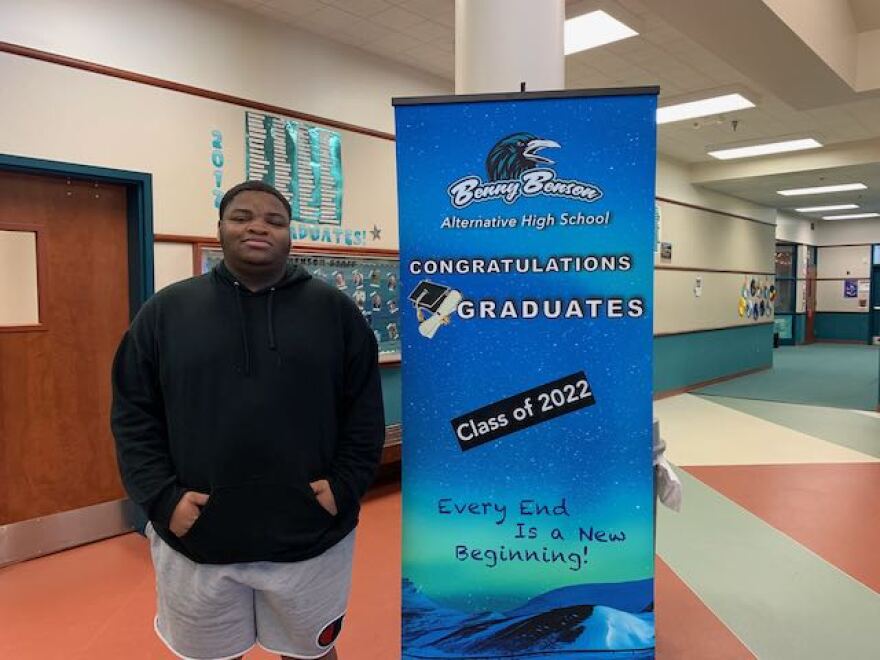Eighteen-year-old Khajaun Ewing sat in his school counselor’s office at Benny Benson Secondary School showing off his new tattoos. On one thigh it reads, “I can do it” in block letters. The other reads, “I will do it.”
“It’s my warrior cry,” he said. “Whenever I’m feeling like I can’t do it, I tell myself, ‘I can do it and I will do it.’ And I push through all obstacles.”
Ewing has plans for his future. He knows he will focus on supporting his family and helping others by studying to become a chiropractor.
“I’m fascinated with all of the different bones in the body,” he said. “The way things work, how you can help someone with all of their different aches and pains over time.”
Listen to this story:
But Ewing didn’t always have this outlook on life. He skipped class to drive around with his friends, ignored his parents’ rules and didn’t care at all about the future. He was failing out of school until he enrolled last August in Benny Benson, a credit recovery program in Anchorage. There, teachers allowed him to work at his own pace, motivated him to keep going and supported him to meet his goals.
“My GPA went from a 1.2 to a 3.5 since I’ve been here,” he said.
He was also on the honor roll for four quarters in a row.
With the encouragement of his mentor, Ewing changed his friend group and sought out people who would be positive influences.
“I noticed I was doing dumb things, so I changed that and I took all of those negative people out of my life,” he said.
The types of changes Ewing made were all related to mental health. In fact, the steps Ewing took such as investing in healthy relationships and finding ways to serve are suggestions made in the Surgeon General’s 2021 advisory on supporting youth mental health. But Ewing would never never frame it that way.
For Ewing mental health means one thing.
“You’re not happy. Not being happy,” he said. “That’s my take on mental health.”
Because that’s exactly how society teaches us to think about it, said Jason Lessard, executive director of the Anchorage chapter of the National Alliance on Mental Illness, a mental health advocacy organization.
“When people hear mental health, they think of mental illness or the negatives of mental health,” he said.
Lessard said often conversations around mental health in the media and in personal interactions focus on negative issues or mental health diagnoses. They don’t focus on the idea that mental health is just another aspect of our overall health, and that it is influenced heavily by the environment and the people around us.
Mental health is tied to our physical health, too. Lack of food can lead to irritability just like anxiety can cause you to have stomach pains, he said.
“I think that's what gets so tricky about mental health and mental well-being and brain health is that it is so connected with so many other things,” Lessard said.
The World Health Organization defines mental health as a state of well-being where people can realize their own abilities, can cope with the normal stresses of life and can make contributions to their communities. This means mental health isn’t just if you have problems or depression, and supporting mental health isn’t just about medications or therapy.
So how do you shift conversations around mental health to be more inclusive of all aspects of it, from the positive things to the negative things? How do you talk about the small things we can do to improve our mental health without being reductive?
“It's a tough one, and I'm not sure that I fully know how to make that change without also sounding, you know, a little too, a little too Pollyanna-ish and prescriptive,” Lessard said.
Part of the problem is that defining mental health and all that it includes can be hard, even for people who work in the field.
“Your mental health is… I don't know how to describe it even,” said peer support specialist Taylor Stapley. He works with teens at VOA-Alaska, a mental health service provider in Anchorage. “It's just your way. Yeah, it's really hard to define that for me.”
Stapely said mental health includes the uplifting feelings and the hard ones. Speaking as both a professional and a person in recovery from addictions, he said that mental health is influenced by everything.
“Everything contributes to it. How people talk to you, how people look at you, how you feel about yourself, how you think other people view you, your self-esteem, your lack of self-esteem. Your mood you're in. Everything contributes to it,” he said.
So how do we get people to think about mental health and talk about it more comprehensively and without fear? Both Lessard and Stapely said it starts with more education.
“The earlier we can have those conversations and talk to kids about their emotions so they understand them a little bit better,” the better we’ll be in the long-run, Lessard said.
Stapely said education has opened up conversations about many issues in the past and can do the same for mental health.
“You don't have to be scared of it. It's just, it is what it is,” Stapely said.
Mental health education is not currently part of the Alaska state education standards, though the state legislature has discussed bills about the issue for the past three legislative sessions. Senator Lisa Murkowski also recently introduced federal legislation to fund mental health promotion and suicide prevention programs in K-12 schools.
This story is part of an ongoing solutions journalism project at Alaska Public Media about destigmatizing mental health. The project is funded by a grant from the Alaska Mental Health Trust but is editorially independent.


